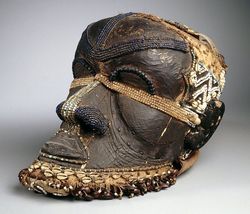Collaborating with WikiAfrica
In September 2012, a representative from WikiAfrica approached us about working with them to provide Africa-related content to the Wikimedia Foundation’s websites. As the WikiAfrica profile states, “Africa deserves a new deal―and especially in Wikipedia.” Africa is the birthplace of humanity and home to over a billion people; the continent represents the world’s third-largest market and is widely recognized as the last frontier for global economic growth. And yet, the WikiAfrica profile states, “it has the lowest and least informed profile of any region on the internet. What does appear is often selective, lacks context and reinforces outdated stereotypes.”
 WikiAfrica’s desire to reach out to us is not surprising given our history as one of the first institutions in the United States to collect and exhibit African material culture as art. Today our collections, numbering more than six thousand pieces, are noted not only for their quality and size but also for the historic role they have played in exposing African art to Americans. The Museum came to assume a leading role in collecting and exhibiting African art primarily through the efforts of its first Curator of Ethnology, Stewart Culin (1858-1929). In 1923, Culin organized the largest exhibition of African art ever assembled. Today, select objects from our collection are displayed in the long-term installation African Innovations.
WikiAfrica’s desire to reach out to us is not surprising given our history as one of the first institutions in the United States to collect and exhibit African material culture as art. Today our collections, numbering more than six thousand pieces, are noted not only for their quality and size but also for the historic role they have played in exposing African art to Americans. The Museum came to assume a leading role in collecting and exhibiting African art primarily through the efforts of its first Curator of Ethnology, Stewart Culin (1858-1929). In 1923, Culin organized the largest exhibition of African art ever assembled. Today, select objects from our collection are displayed in the long-term installation African Innovations.
Our collaboration began with images. We shared our API key with Wikimedia’s “Share Your Knowledge” project so they could upload our digital image assets to WikiCommons. In six months, they uploaded 3,758 files. Unfortunately, many of these images have not yet been used in articles, which turns out to have a direct correlation to number of views.

Bushoong Kuba. Bwoom Mask, late 19th or early 20th century. Wood, cowrie shells, glass beads, fur, leather, cloth, seed pods, 13 3/4 x 8 1/4 x 12 in. (35 x 21 x 30.5 cm). Brooklyn Museum, Gift of the Anne Eisner Putnam Collection, 73.178. Creative Commons-BY
Whether or not an image has been “seeded” (or placed in a corresponding article) has a significant effect on how many people view that image. An image of our Bwoom Mask serves as a striking example of this effect. Standing alone in its uploaded state on Wikimedia Commons, the image received 334 page views within a three month period. Once a Wikipedia user seeded the image in an article about the Kuba Kingdom, the article was viewed 4,942 times within the same period. In other words, the Kuba Kingdom article received 15 times the number of views than the Bwoom Mask image. While some of the 3,758 images uploaded by WikiAfrica have been seeded, the vast majority have not. To be precise, as of this month, 97 of the uploaded images have been used on French Wikipedia, and 70 on English Wikipedia.
However, I realized that there was often no place (or no good place, I should say) to seed these images―there were very few articles of adequate quality that addressed topics related to these objects, and those that did exist were either incomplete or full of false information, or both. The Kuba Kingdom article is a good example. The article offers only 750 words about one of the most powerful and culturally productive kingdoms in African history, and yet over 10,000 people have looked at that article since December. That signifies 10,000 opportunities to expand someone’s understanding of the incredibly rich history and cultural heritage of pre-colonial Africa. That fact alone is a call to action if I’ve ever seen one.
This leads us to my current project augmenting Wikipedia articles on topics related to historical African art, which I will cover in next week’s post.

Alexandra Thom is coordinating a Kress-funded project at the Brooklyn Museum where she works to make scholarly and curatorial information about the Museum’s collections available to the public on Wikipedia. Prior to joining the Museum, Alexandra was the Curatorial Assistant at The Water Tank Project. She is also the co-founder of Archer&Leo, a Brooklyn-based creative agency, and a published author of short fiction. She earned her M.A. from The Courtauld Institute of Art and B.A. from Vassar College.
